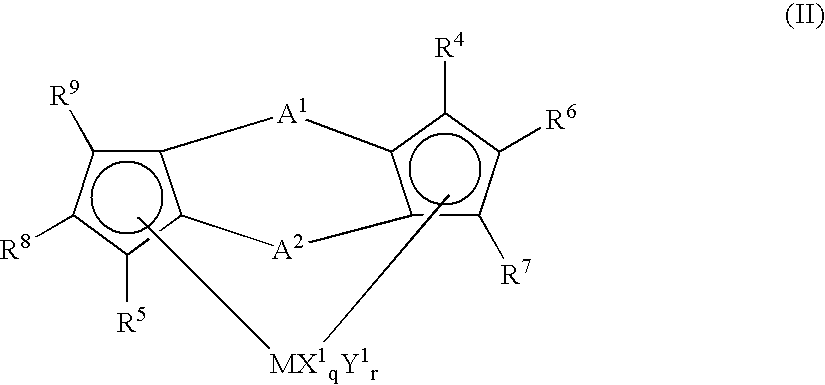Polyolefin resin composition, film, and multilayer structure
a polyolefin resin and polymer technology, applied in the direction of synthetic resin layered products, transportation and packaging, chemistry apparatus and processes, etc., can solve the problems of short crystallinity of sticky components, poor appearance, and film cannot stand practical us
- Summary
- Abstract
- Description
- Claims
- Application Information
AI Technical Summary
Benefits of technology
Problems solved by technology
Method used
Image
Examples
production example 1
Preparation of Polymerizing Catalyst
[0299] (1) Production of 2-chlorodimethylsilylindene
[0300] A three-neck flask of one liter was charged with 50 milliliter of THF (tetrahydrofuran) and 2.5 g (41 millimole) of magnesium under nitrogen flow, and 0.1 milliliter of 2-dibromoethane was added thereto and stirred for 30 minutes to activate magnesium. After stirring, the solvent was drawn out, and 50 milliliter of THF was newly added. A THF solution (200 milliliter) dissolving 5.0 g (25.6 millimole) of 2-bromoindene was dropwise added thereto spending 2 hours. After finishing dropwise adding, the solution was stirred at a room temperature for 2 hours and then cooled down to -78.degree. C., and a THF solution (100 milliliter) dissolving 3.1 milliliter (25.6 millimole) of dichlorodimethylsilane was dropwise added thereto spending one hour. The solution was stirred for 15 hours, and then the solvent was distilled off. The residue was extracted with 200 milliliter of hexane, and then the solv...
production example 2
Production of 1-butene Base Polymer A
[0308] An autoclave of 10 liter, which was dried by heating, was charged with 4 liter of heptane, 2.5 kg of 1-butene, 5 millimole of triisobutylaluminum and 10 millimole of methylaluminoxane, and 0.03 MPa of hydrogen was further introduced thereinto. The temperature was elevated to 60.degree. C. while stirring, and then 10 micromole of (1,2'-dimethylsilylene)(2,1'-dimethylsilylene)-bis(3-trimethylsilylmethyl-indenyl)zirconium dichloride obtained in Production Example 1 to carry out polymerization for 60 minutes. After finishing the polymerization reaction, the reaction product was dried under reduced pressure to thereby obtain 67 g of a 1-butene homopolymer. Shown below are the results obtained by evaluating the resin characteristics of the 1-butene base polymer A thus obtained.
3 Mesopentad ratio (mmmm): mol % 74.1 Racemitriad ratio (rr): mol % 10.9 Abnormal insert amount: mol % 0 (1, 4 insert ratio) Stereospecific index 9.1 (mmmm) / (mmrr + rmmr) ...
production example 3
Production of 1-butene Base Polymer B
[0309] An autoclave of 10 liter, which was dried by heating, was charged with heptane (4 liter), 1-butene (2.6 kg), triisobutylaluminum (10 mmol) and 0.05 MPa of hydrogen. Then, methylaluminoxane (10 mmol) available from Albemarle Co., Ltd. was added thereto, and the temperature was elevated to 50.degree. C. while stirring, followed by adding the complex (1,2'-dimethylsilylene)(2,1'-dimethylsilylene)-bis(3-trimethylsilylmethyl-indenyl)zirconium dichloride (10 .mu.mol) prepared in Production Example 1. After stirring for 150 minutes, methanol (20 mL) was added thereto to remove the pressure, and then the polymerization solution was dried under reduced pressure to thereby obtain poly(1-butene).
[0310] Shown below are the results obtained by evaluating the resin characteristics of the 1-butene base polymer B (1-butene homopolymer) thus obtained.
4 Mesopentad ratio (mmmm): mol % 77.4 Racemitriad ratio (rr): mol % 3.7 90-2 (rr) 82.6 Abnormal insert amou...
PUM
| Property | Measurement | Unit |
|---|---|---|
| temperature | aaaaa | aaaaa |
| melting point | aaaaa | aaaaa |
| molecular weight distribution | aaaaa | aaaaa |
Abstract
Description
Claims
Application Information
 Login to View More
Login to View More - R&D
- Intellectual Property
- Life Sciences
- Materials
- Tech Scout
- Unparalleled Data Quality
- Higher Quality Content
- 60% Fewer Hallucinations
Browse by: Latest US Patents, China's latest patents, Technical Efficacy Thesaurus, Application Domain, Technology Topic, Popular Technical Reports.
© 2025 PatSnap. All rights reserved.Legal|Privacy policy|Modern Slavery Act Transparency Statement|Sitemap|About US| Contact US: help@patsnap.com



